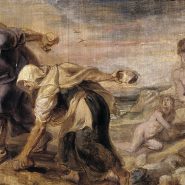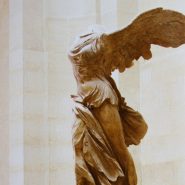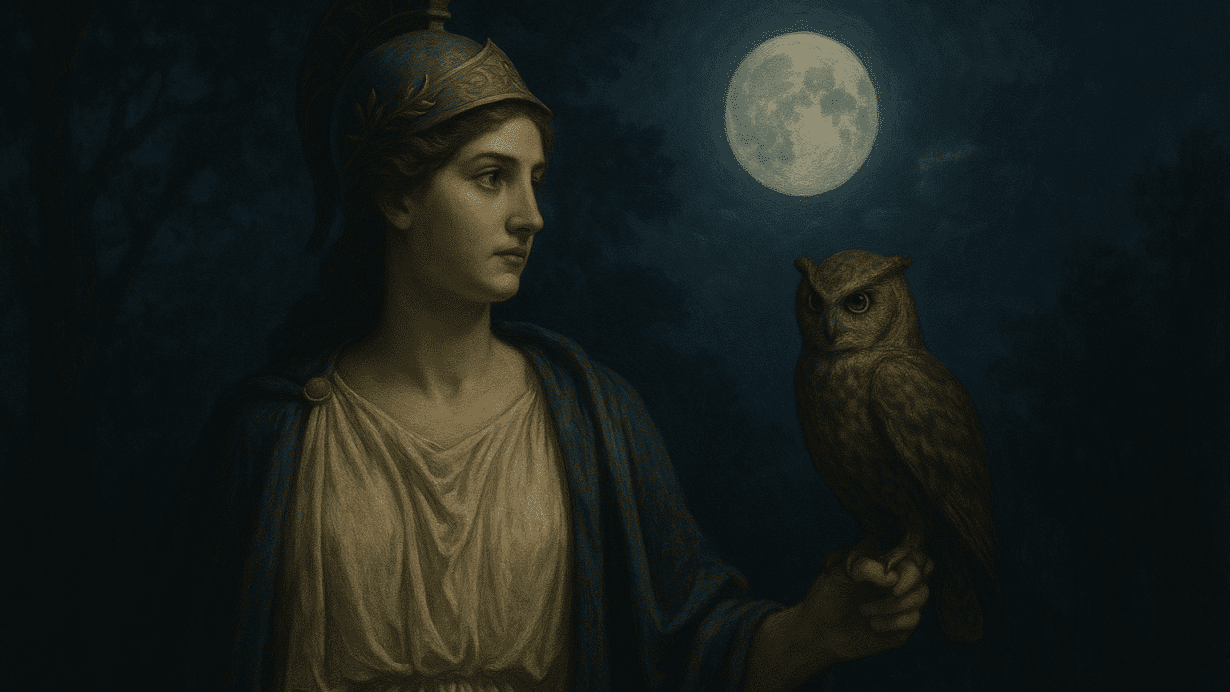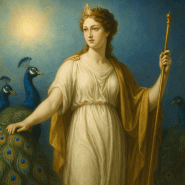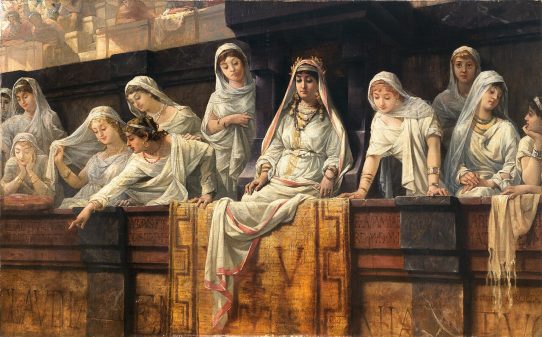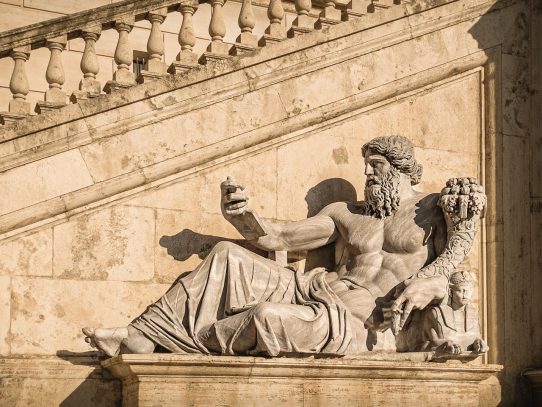In the quiet hours of night, when the rest of the world sleeps, the owl keeps watch. Its unblinking gaze and silent flight have long made it a creature of mystery — an embodiment of insight, perception, and learning.
In Roman mythology, no deity was more closely linked to this nocturnal bird than Minerva, goddess of wisdom, strategy, and the arts. The owl became her constant companion and symbol, representing the light of reason that endures even in darkness.
Minerva and Her Sacred Bird
Minerva was the Roman goddess of intellect and invention, revered as a patron of scholars, craftsmen, and warriors who relied on intellect more than brute force. She was the daughter of Jupiter, born fully armed from his head — a vivid metaphor for the birth of wisdom from the mind of supreme power. Her presence spanned many realms: from the library to the battlefield, from the artist’s workshop to the philosopher’s study.
Her sacred bird, the owl, mirrored this dual nature. Like Minerva, it was both observer and strategist. The owl’s ability to see in the dark symbolized the power of knowledge to pierce ignorance. To the Romans, its large eyes reflected not menace but clarity, its nocturnal habits a reminder that true understanding often comes when the world is still.
The Roots of the Owl Symbol
The image of the owl as a companion to wisdom was not uniquely Roman. It was inherited from the Greeks, for whom the owl represented Athena, the goddess of wisdom and war. In Athens, the bird became a civic emblem, engraved upon coins and shields as a sign of divine guidance. The Romans, who often blended Greek ideas into their own mythology, adopted this association wholeheartedly, transforming Athena’s owl into Minerva’s emblem.
However, the Romans infused the symbol with their own values. Where the Greeks emphasized philosophy and reason, the Romans linked Minerva’s owl to practical intelligence — sapientia not only as knowledge but as discernment and judgment. To the Roman mind, wisdom was not a theoretical pursuit but a tool for governance, strategy, and moral clarity.
Seeing in Darkness: The Symbolic Vision of the Owl
The owl’s most defining feature — its ability to see in near-total darkness — captured the essence of Minerva’s wisdom. Knowledge, like vision, is most valuable when it reveals what others cannot see. The owl’s eyes, fixed and glowing, became symbols of perception beyond illusion.
Romans believed that to be wise was to see truth where others saw confusion. Minerva’s owl embodied this rare capacity. In a world full of uncertainty, it was the emblem of clarity, reason, and foresight. Its nocturnal vigilance reflected the goddess’s own role as a protector of thoughtful action, guiding mortals toward balance and understanding.
The owl also symbolized silence — the ability to observe before speaking. This trait was admired in Roman statesmanship and philosophy, where restraint and reflection were hallmarks of virtue. The owl’s quiet flight through the night sky mirrored the contemplative nature of wisdom itself: unseen yet ever present, calm yet powerful.
The Owl in Roman Art and Literature
In Roman art, the owl often appeared beside Minerva’s figure, perched on her shoulder or resting near her shield. Statues and reliefs portrayed her in full armor, the bird watching from her side as though keeping counsel. On coins, especially during the later Empire, the owl stood as a mark of learned authority, appearing on medallions issued in honor of emperors who wished to associate themselves with intellect and prudence.
Writers, too, drew upon the owl’s imagery. Poets such as Ovid and Virgil invoked Minerva’s bird as a symbol of wisdom, prudence, and sometimes foreboding. In their works, the owl’s cry could signal a divine message — a warning, a revelation, or the arrival of insight. The Romans respected its nocturnal mystery even as they feared its voice, recognizing that wisdom often speaks in ways that disturb complacency.
The Dual Nature of the Owl: Wisdom and Omen
The owl’s connection to wisdom was not without its shadows. Romans, like many ancient peoples, saw in the bird both blessing and portent. While sacred to Minerva, the owl was also considered an omen of death or misfortune when sighted at the wrong moment. Its cry, especially when heard in the city, was taken as a sign that change — sometimes grave — was approaching.
This dual symbolism reflected the Roman understanding of knowledge itself: enlightenment can be unsettling. Wisdom demands awareness of both beauty and sorrow, triumph and loss. The owl’s presence in myth reminded Romans that to see deeply is also to confront uncomfortable truths.
Yet in Minerva’s hands, this duality became harmonious. She represented the wise use of knowledge — the discipline to wield insight for good. The owl, therefore, was not a messenger of doom but a keeper of truth, guiding the mind through the shadows of ignorance toward the light of understanding.
Minerva’s Influence and the Legacy of the Owl
Minerva’s temples, especially on the Capitoline Hill in Rome, featured owl motifs carved into columns and altars. These birds symbolized divine insight watching over civic life. In education, artisans and scholars invoked Minerva’s name and the image of her owl for inspiration. Even as Roman religion faded, her symbolism endured in medieval and Renaissance art.
Artists like Raphael and Botticelli painted Minerva (or her Greek counterpart, Athena) with an owl at her side — sometimes perched quietly, sometimes gazing outward at the viewer. The Enlightenment later revived the symbol as a metaphor for reason itself. The philosopher Hegel famously declared that “the owl of Minerva spreads its wings only with the falling of the dusk,” suggesting that wisdom arrives at the end of an era, in reflection rather than anticipation.
Through all these ages, the owl retained its ancient Roman essence: the capacity to see clearly when all else grows dim.
The Owl as an Enduring Symbol
Today, the owl remains one of the most universal symbols of wisdom, its image adorning libraries, universities, and emblems of learning. Few remember that this association began with a goddess whose intellect balanced power with restraint. Minerva’s owl continues to represent the Roman ideal that knowledge must serve virtue, that wisdom without morality is blind.
In the silent figure of the owl, perched beneath the moonlight, we glimpse Minerva’s enduring spirit: the vigilant guardian of thought, the quiet companion of reason, the watchful eye of understanding that outlasts the night.
